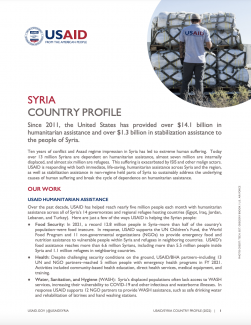Since 2011, the United States has provided over $14.1 billion in humanitarian assistance and over $1.3 billion in stabilization assistance to the people of Syria.
Ten years of conflict and Assad regime impression in Syria has led to extreme human suffering. Today over 13 million Syrians are dependent on humanitarian assistance, almost seven million are internally displaced, and almost six million are refugees. This suffering is exacerbated by ISIS and other malign actors. USAID is responding with both immediate, life-saving, humanitarian assistance across Syria and the region, as well as stabilization assistance in non-regime held parts of Syria to sustainably address the underlying causes of human suffering and break the cycle of dependence on humanitarian assistance.
OUR WORK
USAID HUMANITARIAN ASSISTANCE
Over the past decade, USAID has helped reach nearly five million people each month with humanitarian assistance across all of Syria’s 14 governorates and regional refugee hosting countries (Egypt, Iraq, Jordan, Lebanon, and Turkey). Here are just a few of the ways USAID is helping the Syrian people:
- Food Security: In 2021, a record 12.8 million people in Syria–more than half of the country’s population–were food insecure. In response, USAID supports the UN Children’s Fund, the World Food Program and 11 non-governmental organizations (NGOs) to provide emergency food and nutrition assistance to vulnerable people within Syria and refugees in neighboring countries. USAID’s food assistance reaches more than 6.6 million Syrians, including more than 5.5 million people inside Syria and 1.1 million refugees in neighboring countries.
- Health: Despite challenging security conditions on the ground, USAID/BHA partners–including 13 UN and NGO partners–reached 5 million people with emergency health programs in FY 2021. Activities included community-based health education, direct health services, medical equipment, and training.
- Water, Sanitation, and Hygiene (WASH): Syria’s displaced populations often lack access to WASH services, increasing their vulnerability to COVID-19 and other infectious and waterborne illnesses. In response USAID supports 12 NGO partners to provide WASH assistance, such as safe drinking water and rehabilitation of latrines and hand washing stations.
USAID STABILIZATION ASSISTANCE
Since 2011, the United States has provided more than $1.3 billion in stabilization assistance in non-Assad regime held parts of Syria. Since the defeat of ISIS’s physical caliphate, USAID has helped communities across Al Raqqa, Deir ez-Zour, and Al Hasakah governorates in northeast Syria recover.
- Improving Access to Essential Services: Access to services such as water, electricity, and healthcare are critical to communities in Syria. Since 2017, USAID has helped provide potable water to over 850,000 people and irrigate nearly 51,000 acres of farmland. In addition, USAID has rehabilitated six power stations as well as over 80 miles of transmission lines, bringing more reliable electricity to nearly 1million Syrians.
- Supporting Livelihoods and Economic Recovery: Syria’s deteriorating economy is a threat to its stability. In northeast Syria, USAID is helping local businesses improve and expand their operations, attract private sector investment, and create an enabling environment for growth. For example, in 2021, USAID increased local production in key industries, such as wheat and poultry, by providing nearly 3,000 metric tons of high-quality wheat seeds to farmers and crucial equipment to 27 registered poultry farms, respectively. USAID also improved access to clean energy technologies like solar pumps and drip irrigation systems for over 2,000 Syrian farmers.
- Strengthening Local Governance as an Alternative to Extremism: USAID is helping local communities and civil society better manage public services and integrate internally displaced persons (IDPs) and returnees. For example, USAID is providing human rights training to the Deir ez-Zour Humanitarian Affairs Office to ensure the human rights of IDPs and returnees are protected, while holding local authorities accountable to community-defined goals.
- Combating the COVID-19 Pandemic: In 2020 USAID transformed a warehouse into a medical-grade oxygen bottling plant that could produce approximately 100 6,500-liter tanks per day, providing much needed oxygen supplies to local hospitals serving 1.5 million Syrians. USAID supported the rehabilitation of 10 clinics and hospitals across northeast Syria, including the Raqqa Comprehensive Health Clinic, a complex which serves over 2,400 COVID patients per month. With support from USAID, the Jazeera Health Commission began rehabilitating Hasakah National Hospital, which is currently serving over 15,300 COVID and non-COVID patients per month. USAID is also building solar-powered cold storage facilities to safely store thousands of vaccines at a time.
DONOR COORDINATION
The United States, through USAID, supports the Syria Recovery Trust Fund (SRTF)—a multi-donor trust fund which serves to channel funding from the international community with the objective to alleviate the suffering of the Syrian people. To date, more than 8 million Syrians have benefited from the SRTF’s essential services restoration and agriculture and food security assistance.

